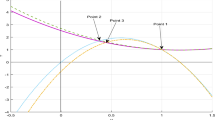Abstract
A closed self-consistent model of a nonequilibrium flow of a mixture of carbon dioxide and argon behind the front of a plane shock wave is developed. The generalized Chapman–Enskog method in the three-temperature approach, which takes into account different channels of vibrational relaxation in a carbon-dioxide molecule, is used. An extended system of Navier–Stokes–Fourier equations consisting of mass-, momentum-, and energy-conservation equations supplemented by diffusion equations for the mixture components and relaxation equations for vibrational modes of the CO2 molecule are written. Constitutive relations for the stress tensor, diffusion velocity, heat flux, and vibrational energy fluxes are obtained. An algorithm for calculating the coefficients of shear and bulk viscosity, the thermal conductivity of different degrees of freedom, diffusion and thermal diffusion are developed and implemented. The model is validated by comparing calculated transport coefficients with experimental data for the viscosity and thermal conductivity of carbon dioxide and argon and for the binary diffusion coefficient. Good agreement with the experiment is obtained. The dependence of transport coefficients on the gas temperature, vibrational-mode temperatures, and mixture composition is analyzed. The developed model is ready for use in the numerical simulation of shock waves in a CO2–Ar mixture.




Similar content being viewed by others
REFERENCES
L. D. Pietanza, O. Guaitella, V. Aquilanti, and I. Armenise, “Advances in non-equilibrium CO2 plasma kinetics: A theoretical and experimental review,” Eur. Phys. J. D 75, 237 (2021). https://doi.org/10.1140/epjd/s10053-021-00226-0
E. A. Nagnibeda and E. V. Kustova, Nonequilibrium Reacting Gas Flows: Kinetic Theory of Transport and Relaxation Processes (Springer, Berlin, 2009).
I. Alekseev and E. Kustova, “Extended continuum models for shock waves in CO2,” Phys. Fluids 33, 096101 (2021).
I. V. Alekseev and E. V. Kustova, “Numerical simulations of shock waves in viscous carbon dioxide flows using finite volume method,” Vestn. St. Petersburg Univ: Math. 53, 500–510 (2020). https://doi.org/10.1134/S1063454120030024
E. V. Kustova and E. A. Nagnibeda, “On a correct description of a multi-temperature dissociating CO2 flow,” Chem. Phys. 321, 293–310 (2006).
T. Elizarova, A. Khokhlov, and S. Montero, “Numerical simulation of shock wave structure in nitrogen,” Phys. Fluids 19, 068102 (2007).
M. Y. Timokhin, H. Struchtrup, A. A. Kokhanchik, and Y. A. Bondar, “Different variants of R13 moment equations applied to the shock-wave structure,” Phys. Fluids 29, 037105 (2017).
G. V. Shoev, M. Y. Timokhin, and Y. A. Bondar, “On the total enthalpy behavior inside a shock wave,” Phys. Fluids 32, 041703 (2020).
I. Wysong, S. Gimelshein, Y. Bondar, and M. Ivanov, “Comparison of direct simulation Monte Carlo chemistry and vibrational models applied to oxygen shock measurements,” Phys. Fluids 26, 043101 (2014).
H. Alsmeyer, “Density profiles in argon and nitrogen shock waves measured by the absorption of an electron beam,” J. Fluid Mech. 74, 497–513 (1976).
L. B. Ibraguimova, A. L. Sergievskaya, V. Yu. Levashov, O. P. Shatalov, Yu. V. Tunik, and I. E. Zabelinskii, “Investigation of oxygen dissociation and vibrational relaxation at temperatures 4000–10 800 K,” J. Chem. Phys. 139, 034317 (2013). https://doi.org/10.1063/1.4813070
J. W. Streicher, A. Krish, and R. K. Hanson, “Coupled vibration-dissociation time-histories and rate measurements in shock-heated, nondilute O2 and O2–Ar mixtures from 6000 to 14 000 K,” Phys. Fluids 33, 056107 (2021). https://doi.org/10.1063/5.0048059
A. Farooq, J. B. Jeffries, and R. K. Hanson, “Sensitive detection of temperature behind reflected shock waves using wavelength modulation spectroscopy of CO2 near 2.7 μm,” Appl. Phys. B 96, 161–173 (2009).
E. Kustova and M. Mekhonoshina, “Multi-temperature vibrational energy relaxation rates in CO2,” Phys. Fluids 32, 096101 (2020). https://doi.org/10.1063/5.0021654
N. B. Vargaftik, Tables on the Thermophysical Properties of Liquids and Gases (Nauka, Moscow, 1972; Hemisphere, Washington, DC, 1975).
R. D. Trengove and W. A. Wakeham, “The viscosity of carbon dioxide, methane, and sulfur hexafluoride in the limit of zero density,” J. Phys. Chem. Ref. Data 16, 175 (1987). https://doi.org/10.1063/1.555777
Handbook of Physical Quantities, Ed. by I. S. Grigoriev and E. Z. Meilikhov (Energoatomizdat, Moscow, 1991; CRC, Boca Raton, Fla., 1995).
Funding
This work was supported by St. Petersburg State University, project no. 93022273.
Author information
Authors and Affiliations
Corresponding authors
Ethics declarations
The authors declare that they have no conflicts of interest.
Additional information
Translated by O. Pismenov
About this article
Cite this article
Batalov, S.A., Kustova, E.V. Modeling of Nonequilibrium Processes behind a Shock Wave in a Mixture of Carbon Dioxide and Argon. Vestnik St.Petersb. Univ.Math. 56, 203–211 (2023). https://doi.org/10.1134/S1063454123020024
Received:
Revised:
Accepted:
Published:
Issue Date:
DOI: https://doi.org/10.1134/S1063454123020024




